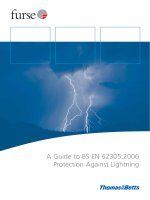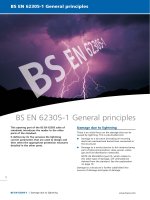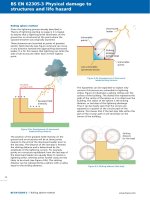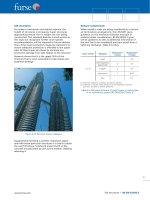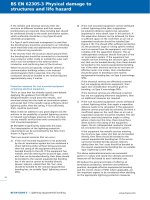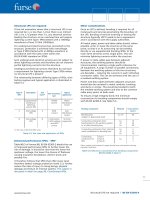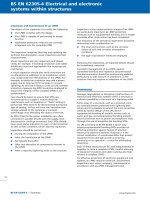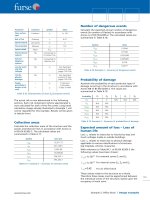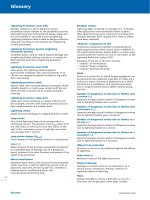Bsi bs en 00482 2012 + a1 2015
Bạn đang xem bản rút gọn của tài liệu. Xem và tải ngay bản đầy đủ của tài liệu tại đây (1.53 MB, 26 trang )
BS EN 482:2012+A1:2015
BS EN 482:2012
BSI Standards Publication
Workplace exposure —
General requirements for the
performance of procedures for
the measurement of chemical
agents
BS EN 482:2012+A1:2015
BRITISH STANDARD
National foreword
This British Standard is the UK implementation of EN 482:2012+A1:2015.
It supersedes BS EN 482:2012 which is withdrawn.
BSI, as a member of CEN, is obliged to publish EN 482:2012+A1:2015 as
a British Standard. However, attention is drawn to the fact that during
the development of this European Standard, the UK committee voted
against its approval as a European Standard.
The reason for this is due to the inclusion of new subclause ‘5.4.6
Chemical agents with low limit values’. This new subclause allows
the use of methods with greater variability for ‘low’ exposure limits,
undermining the existing performance criteria.
The start and finish of text introduced or altered by amendment is
indicated in the text by tags. Tags indicating changes to CEN text carry
the number of the CEN amendment. For example, text altered by CEN
amendment A1 is indicated by .
The UK participation in its preparation was entrusted by Technical
Committee EH/2, Air quality, to Subcommittee EH/2/2, Work place
atmospheres.
A list of organizations represented on this subcommittee can be
obtained on request to its secretary.
This publication does not purport to include all the necessary provisions
of a contract. Users are responsible for its correct application.
© The British Standards Institution 2015.
Published by BSI Standards Limited 2015
ISBN 978 0 580 85704 1
ICS 13.040.30
Compliance with a British Standard cannot confer immunity from
legal obligations.
This British Standard was published under the authority of the Standards
Policy and Strategy Committee on 30 April 2012.
Amendments/corrigenda issued since publication
Date
Text affected
30 November 2015
Implementation of CEN amendment A1:2015
EN 482:2012+A1
EUROPEAN STANDARD
NORME EUROPÉENNE
EUROPÄISCHE NORM
October 2015
ICS 13.040.30
Supersedes EN 482:2012
English Version
Workplace exposure - General requirements for the
performance of procedures for the measurement of
chemical agents
Exposition sur les lieux de travail - Exigences générales
concernant les performances des procédures de
mesure des agents chimiques
Exposition am Arbeitsplatz - Allgemeine
Anforderungen an die Leistungsfähigkeit von
Verfahren zur Messung chemischer Arbeitsstoffe
This European Standard was approved by CEN on 9 March 2012 and includes Amendment 1 approved by CEN on 15 August
2015.
CEN members are bound to comply with the CEN/CENELEC Internal Regulations which stipulate the conditions for giving this
European Standard the status of a national standard without any alteration. Up-to-date lists and bibliographical references
concerning such national standards may be obtained on application to the CEN-CENELEC Management Centre or to any CEN
member.
This European Standard exists in three official versions (English, French, German). A version in any other language made by
translation under the responsibility of a CEN member into its own language and notified to the CEN-CENELEC Management
Centre has the same status as the official versions.
CEN members are the national standards bodies of Austria, Belgium, Bulgaria, Croatia, Cyprus, Czech Republic, Denmark, Estonia,
Finland, Former Yugoslav Republic of Macedonia, France, Germany, Greece, Hungary, Iceland, Ireland, Italy, Latvia, Lithuania,
Luxembourg, Malta, Netherlands, Norway, Poland, Portugal, Romania, Slovakia, Slovenia, Spain, Sweden, Switzerland, Turkey and
United Kingdom.
EUROPEAN COMMITTEE FOR STANDARDIZATION
COMITÉ EUROPÉEN DE NORMALISATION
EUROPÄISCHES KOMITEE FÜR NORMUNG
CEN-CENELEC Management Centre: Avenue Marnix 17, B-1000 Brussels
© 2015 CEN
All rights of exploitation in any form and by any means reserved
worldwide for CEN national Members.
Ref. No. EN 482:2012+A1:2015 E
BS EN 482:2012+A1:2015
EN 482:2012+A1:2015 (E)
Contents
Page
European foreword....................................................................................................................................................... 4
Introduction .................................................................................................................................................................... 5
1
Scope .................................................................................................................................................................... 6
2
Normative references .................................................................................................................................... 6
3
Terms and definitions ................................................................................................................................... 7
4
4.1
4.2
4.3
4.4
Classification ..................................................................................................................................................... 7
General ................................................................................................................................................................ 7
Screening measurements of time weighted average concentration ............................................ 7
Screening measurements of variation of concentration in time and/or space ........................ 7
Measurements for comparison with (occupational exposure) limit values and
periodic measurements ................................................................................................................................ 7
5
5.1
5.2
5.3
5.4
5.4.1
5.4.2
5.4.3
5.4.4
5.4.5
5.4.6
5.5
5.6
5.7
5.8
5.9
5.10
Performance requirements ......................................................................................................................... 7
General ................................................................................................................................................................ 7
Screening measurements of time weighted average concentration ............................................ 8
Screening measurements of variation of concentration in time and/or space ........................ 8
Measurements for comparison with limit values and periodic measurements....................... 8
Unambiguity ...................................................................................................................................................... 8
Selectivity ........................................................................................................................................................... 8
Averaging time ................................................................................................................................................. 8
Measuring range .............................................................................................................................................. 9
Expanded uncertainty ................................................................................................................................... 9
Chemical agents with low limit values .................................................................................................... 9
Composite procedures .................................................................................................................................. 9
Transport and storage................................................................................................................................... 9
Environmental conditions ........................................................................................................................ 10
Description of measuring procedure .................................................................................................... 10
Dimension of result ..................................................................................................................................... 10
Additional requirements ........................................................................................................................... 10
6
Test method ................................................................................................................................................... 10
7
Validation report .......................................................................................................................................... 11
Annex A (informative) Structure of a method description......................................................................... 12
Annex B (informative) Calculation of uncertainty of measurement....................................................... 13
B.1
General ............................................................................................................................................................. 13
B.2
Uncertainty associated with sampled air volume or mass uptake ............................................ 14
B.2.1 Pumped sampling......................................................................................................................................... 14
B.2.1.1 Sources of uncertainty................................................................................................................................ 14
B.2.1.2 Flow rate measurement ............................................................................................................................. 14
B.2.1.3 Pump flow stability...................................................................................................................................... 15
BS EN 482:2012+A1:2015
EN 482:2012+A1:2015 (E)
B.2.1.4 Sampling time ................................................................................................................................................ 16
B.2.2 Diffusive sampling ........................................................................................................................................ 16
B.2.2.1 Sources of uncertainty ................................................................................................................................ 16
B.2.2.2 Uptake rate...................................................................................................................................................... 16
B.2.2.3 Sampling time ................................................................................................................................................ 16
B.3
Uncertainty associated with sampling efficiency.............................................................................. 16
B.3.1 Pumped sampling methods for gases and vapours .......................................................................... 16
B.3.2 Diffusive sampling methods for gases and vapours ......................................................................... 17
B.3.3 Aerosol sampling methods ........................................................................................................................ 17
B.3.3.1 General ............................................................................................................................................................. 17
B.3.3.2 Closeness of matching with the required sampling convention(s) ............................................ 17
B.3.3.3 Uncertainty components for aerosol samplers – Estimates for general use ........................... 17
B.3.3.4 Efficiency of the collection substrate..................................................................................................... 18
B.3.3.4.1
Filter materials...................................................................................................................................... 18
B.3.3.4.2
Foams ........................................................................................................................................................ 18
B.4
Uncertainty associated with sample storage and transportation............................................... 18
B.4.1 Sample storage .............................................................................................................................................. 18
B.4.2 Transportation .............................................................................................................................................. 18
B.4.2.1 Gas samples and vapour samples ........................................................................................................... 18
B.4.2.2 Aerosol samples ............................................................................................................................................ 18
B.5
Uncertainty associated with method recovery for gases and vapours ..................................... 18
B.6
Uncertainty associated with analytical recovery for airborne particles and mixtures
of airborne particles and vapour ............................................................................................................ 19
B.7
Uncertainty associated with method variability for gases and vapours .................................. 19
B.8
Uncertainty associated with analytical variability for airborne particles and
mixtures of airborne particles and vapour ......................................................................................... 19
B.9
General equation for combination of uncertainty components .................................................. 20
Bibliography ................................................................................................................................................................. 21
BS EN 482:2012+A1:2015
EN 482:2012+A1:2015 (E)
European foreword
This document (EN 482:2012+A1:2015) has been prepared by Technical Committee CEN/TC 137
“Assessment of workplace exposure to chemical and biological agents”, the secretariat of which is held
by DIN.
This European Standard shall be given the status of a national standard, either by publication of an
identical text or by endorsement, at the latest by April 2016, and conflicting national standards shall be
withdrawn at the latest by April 2016.
Attention is drawn to the possibility that some of the elements of this document may be the subject of
patent rights. CEN [and/or CENELEC] shall not be held responsible for identifying any or all such patent
rights.
This document includes Amendment 1 approved by CEN on 2015-08-15.
This document supersedes !EN 482:2012".
The start and finish of text introduced or altered by amendment is indicated in the text by tags !".
!deleted text"
According to the CEN/CENELEC Internal Regulations, the national standards organizations of the
following countries are bound to implement this European Standard: Austria, Belgium, Bulgaria,
Croatia, Cyprus, Czech Republic, Denmark, Estonia, Finland, Former Yugoslav Republic of Macedonia,
France, Germany, Greece, Hungary, Iceland, Ireland, Italy, Latvia, Lithuania, Luxembourg, Malta,
Netherlands, Norway, Poland, Portugal, Romania, Slovakia, Slovenia, Spain, Sweden, Switzerland,
Turkey and the United Kingdom.
BS EN 482:2012+A1:2015
EN 482:2012+A1:2015 (E)
Introduction
National laws and regulations based on European Directives require the assessment of the potential
exposure of a worker to chemical agents in workplace atmospheres. One way of assessing such
exposure is to measure the concentration of a chemical agent in the air in the worker's breathing zone.
The procedures used for such measurements should give reliable and valid results, so that when
compared with set occupational exposure limit values, a correct decision can be made, for instance, as
to whether the exposure level is acceptable or control measures need to be applied.
!Because of their importance in the process of exposure assessment, it is required that the measuring
procedures fulfil some general requirements which are given in this document. Specific European
Standards have been prepared for different types of measuring procedures and measuring devices.
These include European Standards for airborne particle samplers (EN 13205-1), diffusive samplers
(EN 838), pumped samplers (EN 1076), detector tubes (EN ISO 17621), sampling pumps
(EN ISO 13137), metals and metalloids (EN 13890), mixtures of airborne particles and vapour
(EN 13936) and direct reading instruments (EN 45544 (all parts)). In these specific European
Standards, additional requirements have been included for the procedure or device in question, so that
the general requirements of this document are not compromised. Where no specific European Standard
exists, only the general requirements apply."
Performance requirements are given in this document for unambiguity, selectivity, averaging time,
measuring range and expanded uncertainty for minimum specified measuring ranges. These
requirements are intended to apply under environmental conditions present at the workplace.
However, because a wide range of environmental conditions are encountered in practice, this document
specifies requirements that have to be fulfilled by measuring procedures when tested under prescribed
laboratory conditions.
It is the user's responsibility to choose the appropriate procedures or devices that meet the
requirements of this document. One way of doing this is to obtain information or confirmation from the
provider of a procedure or the manufacturer of a device. Type-testing or, more generally, assessment of
the performance of procedures or devices, can be undertaken by the manufacturer, user, test house or
research and development laboratory, as is most appropriate. A number of existing procedures for
workplace measurements have either been tested over a part of the required minimum measuring
range, but not over the entire range, or have not been tested for all environmental influences and
potential interferences. If these partially validated procedures meet the performance requirements of
this European Standard, they can be used at present. Nevertheless these procedures should be tested
over the full ranges as soon as is reasonably practicable. If there is no measuring procedure for a
chemical agent which meets the requirements of this document, a procedure should be used whose
performance is closest to the specified requirements.
BS EN 482:2012+A1:2015
EN 482:2012+A1:2015 (E)
1 Scope
!This European Standard specifies general requirements for the performance of procedures for the
determination of the concentration of chemical agents in workplace atmospheres as required by the
Chemical Agents Directive 98/24/EC (see reference [9]). The requirements given apply to all measuring
procedures, irrespective of the physical form of the chemical agent (gas, vapour, airborne particles), the
sampling method and the analytical method used."
This European Standard is applicable to
— all steps of a measuring procedure,
— measuring procedures with separate sampling and analysis steps, and
— direct-reading devices.
2 Normative references
The following documents, in whole or in part, are normatively referenced in this document and are
indispensable for its application. For dated references, only the edition cited applies. For undated
references, the latest edition of the referenced document (including any amendments) applies.
!EN 481, Workplace atmospheres - Size fraction definitions for measurement of airborne particles
EN 838, Workplace exposure - Procedures for measuring gases and vapours using diffusive samplers Requirements and test methods
EN 1076, Workplace exposure - Procedures for measuring gases and vapours using pumped samplers Requirements and test methods
EN 1540, Workplace exposure - Terminology
EN 13205-1, Workplace exposure - Assessment of sampler performance for measurement of airborne
particle concentrations - Part 1: General requirements
EN 13890, Workplace exposure - Procedures for measuring metals and metalloids in airborne particles Requirements and test methods
EN 13936, Workplace exposure - Procedures for measuring a chemical agent present as a mixture of
airborne particles and vapour - Requirements and test methods
EN 45544 (all parts), Workplace atmospheres — Electrical apparatus used for the direct detection and
direct concentration measurement of toxic gases and vapours
EN ISO 13137, Workplace atmospheres — Pumps for personal sampling of chemical and biological agents
— Requirements and test methods (ISO 13137)
EN ISO 17621, Workplace atmospheres — Short term detector tube measurement systems —
Requirements and test methods (ISO 17621)
ISO 78-2, Chemistry — Layouts for standards — Part 2: Methods of chemical analysis"
BS EN 482:2012+A1:2015
EN 482:2012+A1:2015 (E)
3 Terms and definitions
For the purposes of this document, the terms and definitions given in EN 1540 apply.
4 Classification
4.1 General
In this document, measurements are classified according to their purpose. These classifications are
based upon the measurement strategy laid down in EN 689.
4.2 Screening measurements of time weighted average concentration
Screening measurements of time weighted average concentration are performed to obtain relatively
crude quantitative information on exposure levels. Such information is used to identify potential health
hazards, and to estimate the risk to health based on the likely severity of harm and the probability of its
occurrence. These measurements can also determine if the exposure is significantly below or
significantly above the (occupational exposure) limit value.
4.3 Screening measurements of variation of concentration in time and/or space
Screening measurements of variation of concentration in time and/or space are used to:
a) provide information on the likely pattern of the concentration of chemical agents in the air,
b) identify locations and periods of elevated exposure,
c) provide information on the location and intensity of emission sources, and
d) estimate the effectiveness of ventilation or other technical measures.
4.4 Measurements for comparison with (occupational exposure) limit values and
periodic measurements
Measurements for comparison with (occupational exposure) limit values are used to obtain results of
known uncertainty for the average concentration of a chemical agent in the air in a worker’s breathing
zone.
Periodic measurements are used to determine whether exposure conditions have changed since the
measurements for comparison with limit values were performed, or whether control measures remain
effective.
NOTE
Since the composition of the workplace atmosphere will have been investigated during the initial
occupational exposure assessment, it might be appropriate for periodic measurements to use procedures with
lower selectivity.
5 Performance requirements
5.1 General
Performance requirements for measuring procedures depend on the purpose for which they are used.
The performance requirements for screening measurements are less stringent than for measurements
for the comparison with limit values and periodic measurements. Therefore, the performance
requirements for screening measurements in 5.2 and 5.3 are only given in general terms.
BS EN 482:2012+A1:2015
EN 482:2012+A1:2015 (E)
5.2 Screening measurements of time weighted average concentration
The measurement procedures shall have:
a) adequate selectivity for the chemical agent (see 4.2),
b) averaging time less than or equal to the limit value reference period,
c) measuring range that includes the limit value, and
d) expanded uncertainty that is fit for purpose (see 4.2).
5.3 Screening measurements of variation of concentration in time and/or space
The measuring procedures shall have:
a) adequate selectivity for the chemical agent (see 4.3),
b) short averaging time (for variation of concentration in time ≤ 5 min; for variation of concentration
in space ≤ 15 min),
c) measuring range that is fit for purpose (see 4.3), and
d) expanded uncertainty that is fit for purpose (see 4.3).
5.4 Measurements for comparison with limit values and periodic measurements
5.4.1 Unambiguity
A measuring procedure shall produce an unambiguous result for the concentration of the chemical
agent being measured in the specified measuring range, i.e. an analytically determined value shall
correspond to one concentration only.
5.4.2 Selectivity
The measuring procedure shall contain appropriate information about the nature and magnitude of any
interference.
NOTE
Selectivity requirements vary from case to case, depending on what is known in advance about the
workplace air. If the identity of all contaminants present is not known in advance then the measuring procedure
will need to have a high selectivity. If the identity of all contaminants is known prior to measurement and there
are no interferents present, then it might be possible to use a measurement procedure with a low selectivity.
Procedures for measuring chemical agents present as airborne particles shall prescribe a method for
sampling the particle size fraction, as defined in EN 481, for which the limit value for the chemical agent
is set.
If different limit values are set for different species of a chemical agent, then the measuring procedure
shall determine the individual species concerned.
5.4.3 Averaging time
The averaging time is equal to the sampling time, which shall be less than or equal to the limit value
reference period.
BS EN 482:2012+A1:2015
EN 482:2012+A1:2015 (E)
5.4.4 Measuring range
The measuring range of the procedure or instrument shall cover at least the concentrations from 0,1
times to 2 times the limit value for long-term measurements, and from 0,5 times to 2 times the limit
value for short-term measurements.
!NOTE For limit values see reference [10]."
5.4.5 Expanded uncertainty
The requirements for expanded uncertainty are given in Table 1.
Table 1 — Expanded uncertainty requirements for measurements
for comparison with limit values and periodic measurements
reference period
measuring range
relative
expanded
uncertainty
short-term
(e.g. 15 min)
0,5 times to 2 times
limit value
≤ 50 %
0,5 times to 2 times
limit value
≤ 30 %
long-term
long-term
0,1 times to < 0,5 times
limit value
≤ 50 %
relative expanded
uncertainty
(mixtures of airborne
particles and vapour)
≤ 50 %
≤ 50 %
≤ 50 %
NOTE
Variation of exposure to chemical agents in the workplace can be significantly greater than indicated
by the uncertainty of a single measurement calculated according to this European Standard. This is due to the
temporal and spatial variability of workplace exposure.
!
5.4.6 Chemical agents with low limit values
In exceptional cases, the limit value of a chemical agent can be so low that at present no measuring
procedure is available which meets the requirements given in 5.4.4 and 5.4.5. Until a measuring
procedure which fulfils these requirements is available, a measuring procedure should be used whose
performance is closest to the specified requirements.
NOTE
A list of published measuring procedures is available from GESTIS Analytical methods database [11]
which is updated regularly. These measuring procedures are rated according to their compliance with this
European Standard and EN 838, EN 1076, EN 13890 and EN 13936."
5.5 Composite procedures
The performance requirements detailed in 5.2, 5.3 and 5.4 shall be fulfilled for the whole measuring
procedure even if the measuring procedure consists of several distinct steps, e.g. sampling, transport
and storage, sample preparation and analysis. In the latter case, each step of the measuring procedure
may be tested individually as an alternative to testing the measuring procedure as a whole.
5.6 Transport and storage
Transport and storage of samples, if appropriate, shall be carried out in such a way that the physical and
chemical integrity is maintained between sampling and analysis.
BS EN 482:2012+A1:2015
EN 482:2012+A1:2015 (E)
5.7 Environmental conditions
!The effect of environmental conditions (e.g. temperature, relative humidity, atmospheric pressure)
on the performance of the method shall be tested in the laboratory." Performance requirements
concerning unambiguity, selectivity, expanded uncertainty, minimum measuring range and averaging
time shall be fulfilled under the conditions likely to be encountered in the workplace.
NOTE
It is not practicable to carry out a comprehensive evaluation of environmental influences in the field
and therefore laboratory tests are specified in this document. However, field tests can provide valuable
information on the performance of measurement methods.
The range of environmental conditions under which the performance requirements of 5.2 to 5.5 are
fulfilled shall be specified in the measuring procedure.
5.8 Description of measuring procedure
The measuring procedure shall be documented in accordance with ISO 78-2.
An example for the structure of a method description is given in Annex A.
The description shall contain all necessary information to perform the measuring procedure, including
information about the attainable expanded uncertainty, measuring range, averaging time, interferences
and environmental or other conditions that can influence the performance of the measuring procedure.
If correction factors are applied, e.g. for a known and explainable bias due to environmental influences,
these shall be justified in the measuring procedure.
5.9 Dimension of result
The final measurement result shall be expressed in the same units as those of the limit value. This can
be achieved directly or by means of a suitable conversion.
This requirement is not obligatory for screening measurements of the variation of concentration in time
and/or space.
5.10 Additional requirements
!In addition to the requirements given in 5.2 to 5.9, further requirements specified in EN 838,
EN 1076, EN ISO 13137, EN ISO 17621, EN 13205-1, EN 13890, EN 13936 and EN 45544 shall be met
for particular types of measuring procedures and devices, as appropriate."
6 Test method
6.1 Estimate the expanded uncertainty of results obtained using the measuring procedure by carrying
out the tests prescribed in the relevant European Standard(s) specific to the type of procedure or device
concerned, as listed in Clause 2. Carry out measurements at the lower and upper ends of the measuring
range specified in Table 1, and for at least one intermediate concentration. Prepare at least six replicate
samples for each set of tests and analyse the samples under repeatability conditions.
!Calculate the expanded uncertainty, expressed as a percentage, according to the following
procedure (see e.g. references [12], [13], [14] and ISO/IEC Guide 98-3):"
a) specify the measurand;
b) identify all possible sources of uncertainty;
c) quantify the random sampling uncertainty usr and non-random sampling uncertainty usnr;
BS EN 482:2012+A1:2015
EN 482:2012+A1:2015 (E)
d) quantify the random analytical uncertainty uar and non-random analytical uncertainty uanr;
e) calculate the combined random standard uncertainty ucr according to Formula (1) and the
combined non-random standard uncertainty ucnr according to Formula (2):
f)
=
uc r
usr 2 + ua r 2
=
ucnr
usnr 2 + ua nr 2
calculate the combined standard uncertainty uc according to Formula (3);
=
uc
ucr 2 + ucnr 2
g) calculate the expanded uncertainty U, using a coverage factor k = 2, according to Formula (4).
U = 2 × uc
(1)
(2)
(3)
(4)
NOTE 1
Alternatively, the random and non-random components of sampling uncertainty and the random and
non-random components of analytical uncertainty can be combined in a different order to calculate the combined
standard uncertainty.
NOTE 2
Annex B gives information about the different components of sampling uncertainty and analytical
uncertainty.
!NOTE 3 For detailed calculation methods see EN 838, EN 1076, EN 13205-1 and EN 13890."
6.2 Carry out further tests, as appropriate, to investigate the influence of interferences and
environmental parameters, e.g. wind speed, wind direction or direction of sampling device.
6.3 For a measuring procedure consisting of several independent steps (preparation of equipment,
sampling, transport and storage of sample and analysis), each step of the measuring procedure may be
tested individually as an alternative to testing the procedure as a whole. In this case, calculate the
relative expanded uncertainty of the results obtained using the measuring procedure by an appropriate
combination of the uncertainties of all the independent steps.
NOTE
For some chemical agents the performance of one or more of the steps might have to be determined by
means other than direct testing with the chemical agent. For details, see the appropriate specific European
Standard.
7 Validation report
A validation report shall be prepared for each measuring procedure tested, containing at least the test
conditions, the results obtained and the extent to which the measuring procedure complies with the
requirements of this document and other relevant European Standards or International Standards.
BS EN 482:2012+A1:2015
EN 482:2012+A1:2015 (E)
Annex A
(informative)
Structure of a method description
The following major clauses should be present, if applicable:
— Introduction;
— Title;
— Warning and safety precautions;
— Scope;
— Normative references;
— Definitions;
— Principle;
— Reactions;
— Reagents and materials;
— Apparatus and equipment;
— Sampling;
— Transport and storage;
— Analytical procedure;
— Calculation;
— Performance characteristics;
— Quality assurance and control;
— Special cases (e. g. interferences);
— Test report;
— Annexes.
BS EN 482:2012+A1:2015
EN 482:2012+A1:2015 (E)
Annex B
(informative)
Calculation of uncertainty of measurement
B.1 General
!The first step in estimating the uncertainty of measurement according to ISO/IEC Guide 98-3 is to
construct a cause and effect diagram to identify individual random and non-random uncertainty
components (see references [12], [13], [14] and ISO/IEC Guide 98-3)." After simplifying to resolve
any duplication, the resulting diagram can be used to identify components for which uncertainty
estimates are required.
Procedures for the measurement of chemical agents involve two major steps: sampling and analysis.
The following is a typical, but non-exclusive, list of random and non-random uncertainty components:
a) Uncertainty from sampling, associated with:
1) sampled air volume or mass uptake (see B.2);
2) the sampling efficiency (see B.3);
3) sample storage and transportation, if any (see B.4);
b) uncertainty from analyses of gases and vapours (see EN 838 and/or EN 1076), associated with:
1) method recovery;
2) method variability;
3) the calibration;
4) instrument response drift;
c) uncertainty from analyses of airborne particles (see EN 13890) and mixtures of airborne particles
and vapour, associated with:
1) analytical recovery;
2) analytical precision;
3) the calibration;
4) dilution of sample solutions, if applicable;
5) instrument response drift and
6) blank subtraction.
Each of these uncertainty components are estimated or calculated and then combined to obtain an
estimate of the uncertainty of the measurement method as a whole as described in Clause 6.
BS EN 482:2012+A1:2015
EN 482:2012+A1:2015 (E)
Assuming a rectangular probability distribution or a triangular probability distribution, a range ± A,
should be converted into a non-random uncertainty equal to A/√3 or A/√6 respectively.
B.2 Uncertainty associated with sampled air volume or mass uptake
B.2.1 Pumped sampling
B.2.1.1 Sources of uncertainty
For pumped sampling, the sampled air volume has the following sources of uncertainty: flow rate
measurement (see B.2.1.2), pump flow stability (see B.2.1.3) and sampling time (see B.2.1.4).
B.2.1.2 Flow rate measurement
Flow rate measurements can be carried out using a range of different devices, for example rotameters,
mass flow meters, bubble flow meters or dry piston flow meters. Flow rate measurement error arises
from three sources: the calibration of the flow meter (non-random), the reading of the flow meter
(random) and, where appropriate, correction of the flow rate reading to ambient pressure and
temperature.
The uncertainty of the flow rate calibration, ufc, should be estimated from the data given on the flow
meter test certificate.
The uncertainty of the flow rate reading, ufr, should be taken to be the coefficient of variation of
measurements carried out under repeatability conditions.
Examples of uncertainty of flow rate measurement for different types of flow meters are given in Table
B.1.
BS EN 482:2012+A1:2015
EN 482:2012+A1:2015 (E)
Table B.1 — Uncertainty of the flow rate measurement for different types of flow meters
(example data)
Flow meter type
Scale
%
rotameter, 30 cm lengthc
Flow meter type
mass flow meter
Flow meter type
bubble flow meter
dry piston flow meter
a
b
100
Uncertainty of
flow rate calibrationa
%
Uncertainty of
flow rate readingb
%
2,0
0,45
1,6
50
Flow meter
measuring
range
l ⋅ min-1
0,1 to 15
10
Measured
flow rate
l ⋅ min-1
2,0
5,2
Uncertainty of
flow rate readingb
0,61
2,0
%
Measured
flow rate
0,2 to 6
2,0
0,12
2,0
0,59
0 to 0,25
2 to 30
0,5 to 5
0,5 to 25
2,3
Uncertainty of
flow rate calibrationa
Flow cell
measuring
range
l ⋅ min-1
l ⋅ min-1
0,23
%
Uncertainty of
flow rate calibrationa
Uncertainty of
flow rate readingb
0,4
0,35
0,06
0,22
0,41
0,07
0,12
3,0
3,0
%
%
0,1
0,26
The uncertainty of the flow rate calibration assumes a rectangular probability distribution and is calculated using data
from the flow meter calibration certificate.
The uncertainty of the flow rate reading is based on ten measurements.
The uncertainty of the flow rate reading of an analogue flow meter depends upon the resolution of the scale of the
instrument.
c
If the flow rate is measured at several times and not only at the beginning of the sampling, the
uncertainty of the flow rate reading is reduced by a factor of 1/ n , where n is the number of
measurements of the flow rate.
B.2.1.3 Pump flow stability
Pumps for personal air sampling are usually self-regulating and maintain the set flow rate independent
of variation in back pressure. !EN ISO 13137 requires that the flow rate be maintained to within
± 5 % of the set value throughout the sampling period." Assuming a rectangular probability
distribution, the maximum acceptable value of the non-random uncertainty component of the pump
flow stability is 5 3 %
!Actual values for the pump flow stability can be estimated from the value given by manufacturer or
from the results of the tests prescribed in EN ISO 13137, and can be less than 5 %." Assuming a
rectangular probability distribution, the value of the non-random uncertainty component of the pump
flow stability can be calculated according to Formula (B.1):
upfs, nr =
∆ pfs
3
(B.1)
BS EN 482:2012+A1:2015
EN 482:2012+A1:2015 (E)
where
upfs, nr
∆ pfs
B.2.1.4 Sampling time
is the non-random uncertainty component of the pump flow stability;
is the difference between the mean reading of the flow rate at minimum and
maximum back pressure, in percent.
Sampling time can be measured very exactly with a radio-controlled clock, a quartz clock or a
stopwatch. The major source of uncertainty in measurement of sampling time is the accuracy with
which the reading is taken, i.e. to the nearest minute or second.
If the reading is taken to the nearest second, the non-random uncertainty component is very small for
both long-term and short-term measurements and can be negligible. If the reading is taken to the
nearest minute, the non-random component is very small for long-term measurements (e.g. > 2 h) and
can be disregarded, but for short-term measurements it needs to be taken into account.
For example, if time is recorded to the nearest minute, the coefficient of variation is 2,7 % for a
sampling time of 15 min (summing the maximum 0,5 min biases at the start and end of the sampling
period and dividing by the sampling time and √6, assuming a triangular probability distribution).
!In case a pump with an internal timer is used for personal sampling, EN ISO 13137 requires that the
indicated time shall not deviate by more than ± 0,5 % from that of a calibrated timer. The maximum
tolerance for the sampling time is 0,5 %. Assuming a rectangular probability distribution, the maximum
value of a non-random uncertainty component is 0,5/√3 = 0,29 %."
B.2.2 Diffusive sampling
B.2.2.1 Sources of uncertainty
For diffusive sampling, the mass uptake has the following sources of uncertainty: uptake rate (see
B.2.2.2) and sampling time (see B.2.2.3).
B.2.2.2 Uptake rate
The random and non-random uncertainty components of the uptake rate should be estimated from
replicate samples obtained from a test atmosphere, as described in EN 838.
B.2.2.3 Sampling time
See B.2.1.4.
B.3 Uncertainty associated with sampling efficiency
B.3.1 Pumped sampling methods for gases and vapours
Pumped sampling of gases and vapours can be influenced by the pressure, humidity and temperature of
the sampled air, the concentration of chemical agents in the sampled air and by the flow rate. These
factors can affect the sampling capacity and the performance of the sampling process. The uncertainty
associated with these effects is incorporated into the uncertainty component of the method recovery.
However, for pumped samplers the sample volume is kept well below the experimentally established
breakthrough volume (see EN 1076), in which case the sampling efficiency is assumed to be 100 % and
the uncertainty of the sampling efficiency does not need to be taken into account.
BS EN 482:2012+A1:2015
EN 482:2012+A1:2015 (E)
B.3.2 Diffusive sampling methods for gases and vapours
For diffusive sampling, the sampling efficiency has the following sources of uncertainty: back diffusion
and exposure time.
Back diffusion can occur if there is a significant variation in the air concentration of the chemical agent
during the sampling period. It is influenced by the characteristics of the sorbent and the chemical agent,
by the pressure, humidity and temperature of the sampled air and by the mass of chemical agent
sampled. (The latter is a function of its concentration in the sampled air and sampling time.)The nonrandom uncertainty component due to back diffusion can be estimated from the difference of the means
of the results in two sets of replicate samples. The samples are obtained by exposure of the diffusive
samplers for a short period of time to a high concentration of the chemical agent, one of which is
subsequently exposed to clean air for a long period of time, as described in EN 838.
The non-random uncertainty component associated with exposure time can be estimated by the
analysis of replicate samples collected from a test atmosphere, as described in EN 838.
B.3.3 Aerosol sampling methods
B.3.3.1 General
For aerosol sampling methods, the sampling efficiency has the following sources of uncertainty:
closeness of matching with the required sampling convention(s) and efficiency of the collection
substrate.
B.3.3.2 Closeness of matching with the required sampling convention(s)
Aerosol samplers have to follow one or more of the sampling conventions defined in EN 481. Aerosol
sampling methods have random and non-random uncertainty components that arise from how closely
the samplers used match the required sampling convention(s).
!EN 13205-1 specifies how the performance of aerosol measuring procedures is assessed with
respect to the general requirements of this European Standard, through the combination of errors
arising in the sampling, sample transportation/storage and sample preparation/analysis stages.
EN 13205-2 specifies a laboratory performance test based on determining the sampling efficiency as a
function of particle aerodynamic diameter. In EN 13205-4 the sampler performance is assessed by
comparing the measured concentrations by a candidate sampler with those measured by a validated
(reference) sampler for at least three test aerosols with widely different particle size distributions."
B.3.3.3 Uncertainty components for aerosol samplers – Estimates for general use
Sampling efficiency data has been experimentally determined and published for different types of
inhalable, thoracic and respirable samplers. However, at present, this data has not been recalculated
into uncertainty components as required by this document. As long as such information remains
unavailable, the informative estimates of uncertainty components given in EN 13890 can be
temporarily used.
CEN/TR 15230:2005 lists examples of inhalable, thoracic and respirable samplers with the potential to
meet the requirements of EN 481 and EN 13205, and which were (or had been) available on the market
up until 2004.
NOTE
At present, no informative estimates can be given for thoracic samplers.
BS EN 482:2012+A1:2015
EN 482:2012+A1:2015 (E)
B.3.3.4 Efficiency of the collection substrate
B.3.3.4.1 Filter materials
Filter materials should be selected to have a high collection efficiency for the particle size range of
interest, in which case the uncertainty associated with collection efficiency is negligible (see
ISO 15767).
B.3.3.4.2 Foams
When a foam is used as the collection substrate, sampling efficiency and collection efficiency are
interrelated and no uncertainty components need to be added.
B.4 Uncertainty associated with sample storage and transportation
B.4.1 Sample storage
The non-random uncertainty component associated with sample storage can be estimated by analysing
samples collected from a test atmosphere or prepared by spiking sampling media with the chemical
agent of interest. It can be calculated from the difference between the mean results of the replicate
samples analysed immediately after the sampling/spiking and the replicate samples analysed after the
maximum storage period specified in the test method. Storage tests are described in EN 838, EN 1076
and EN 13890.
B.4.2 Transportation
B.4.2.1 Gas samples and vapour samples
For gas samples and vapour samples, it is not necessary to take into consideration any component of
uncertainty other than those associated with sample storage when samples are transported in an
appropriate manner, as specified in the measuring procedure.
B.4.2.2 Aerosol samples
The transport of aerosol samples normally has a component of uncertainty associated with material
losses from the sample substrate or with substrate contamination. !The upper limit for the loading of
the collection substrate can be determined as described in EN 13205-6 or ISO 15767." The nonrandom uncertainty component is determined from the acceptance criteria for the upper limit of
sample loading.
B.5 Uncertainty associated with method recovery for gases and vapours
Method recovery is influenced by several factors. The study of this influence is carried out using test
atmospheres following the tests described in EN 838 and EN 1076. The experimental data collected
from these tests gives representative information about the factors causing variation and bias (relative
to a reference value) that occur in routine applications of the specified measuring procedure (such as
concentration, temperature and humidity). This data can then be used to estimate the uncertainty of the
method as a whole. Measuring procedures for gases and vapours usually prescribe the correction of the
results for analytical recovery. In these cases, method recovery is estimated from the results of the
samples taken from the test atmospheres corrected for analytical recovery.
BS EN 482:2012+A1:2015
EN 482:2012+A1:2015 (E)
B.6 Uncertainty associated with analytical recovery for airborne particles and
mixtures of airborne particles and vapour
Bias is normally eliminated during the development of an analytical method, but this is not always
possible. According to !ISO/IEC Guide 98-3", measurement results should be corrected for bias, if
it is significant. However, this is often not practicable, e.g. in procedures for measurement of metals and
metalloids in workplace air samples, since analytical bias can vary with the sample matrix. Analytical
bias therefore has to be estimated and treated as an uncertainty component.
According to EN 13890, the non-random uncertainty component of the analytical bias can be estimated
using:
— results from the analysis of certified reference materials (CRMs) and/or pure compounds,
— results from inter-laboratory comparisons,
— results from recovery tests carried out on spiked laboratory blanks,
— an acceptable bias range.
It can also be taken to be zero for procedures that incorporate a design-based sample preparation (e.g.
procedures for determination of soluble metals and metalloids, for which the use of specific test
conditions by definition lead to the test result).
B.7 Uncertainty associated with method variability for gases and vapours
The uncertainty associated with method variability can be estimated from method precision data
obtained from the results of the replicate samples collected from the test atmospheres used as
described in EN 838 and EN 1076. Separate uncertainty estimates need to be made for any sources of
systematic error where applicable, (for example for non-random uncertainty associated with the
concentration of calibration solutions, calibration function, dilution of the sample solutions and
instrument response drift).
The uncertainty associated with analytical variability is included in the method variability.
Independent uncertainty estimates associated with analytical variability can be made either from
analytical precision data obtained under repeatability conditions or from data obtained under
reproducibility conditions. In both cases, separate uncertainty estimates need to be made for any
sources of systematic error, where applicable, (for example for non-random uncertainty associated with
the concentration of calibration solutions, calibration function, dilution of the sample solutions and
instrument response drift). When the analytical precision is determined from within laboratory
reproducibility data (for example from quality control data), most random and randomized uncertainty
components of the analytical variability are included (see ISO 21748 for further guidance). When within
laboratory reproducibility data are used, the values obtained for the analytical precision can be higher
than when repeatability data are used because, in this case, between-days precision is included.
B.8 Uncertainty associated with analytical variability for airborne particles and
mixtures of airborne particles and vapour
The uncertainty associated with analytical variability can be estimated either from analytical precision
data obtained under repeatability conditions or from analytical precision data obtained under
reproducibility conditions, as described in EN 13890. In both cases, separate uncertainty estimates
need to be made for any sources of systematic error, where applicable, (for example for non-random
uncertainty associated with the concentration of the calibration standards, calibration function, dilution
BS EN 482:2012+A1:2015
EN 482:2012+A1:2015 (E)
of the sample solution and instrument response drift). When the analytical precision is determined
from laboratory reproducibility data, (for example from quality control data), most random and
randomized uncertainty components are included (see ISO 21748 for further guidance).
B.9 General equation for combination of uncertainty components
To calculate the random and non-random components of sampling uncertainty and analytical
uncertainty, the relevant individual uncertainty components are combined according to Formulae (B.2)
to (B.5) (see also 6.1, NOTE 1 and 6.3, NOTE):
us r =
us nr =
ua r =
ua nr =
jsr
∑u
i =1
sr i
2
jsnr
∑u
i =1
s nr i
ja r
∑u
i =1
ari
i =1
2
(B.3)
2
ja nr
∑u
(B.2)
a nr i
(B.4)
2
(B.5)
where
usr , usnr , ua r and ua nr are the random sampling uncertainty, the non-random sampling uncertainty, the
random analytical uncertainty and the non-random analytical uncertainty, respectively;
usr , usnr , ua r and ua nr are the corresponding relevant individual uncertainty components;
i
i
i
i
jsr , jsnr , ja r and ja nr are the corresponding numbers of relevant individual uncertainty components.
BS EN 482:2012+A1:2015
EN 482:2012+A1:2015 (E)
Bibliography
!
[1]
[2]
EN 689, Workplace atmospheres - Guidance for the assessment of exposure by inhalation to
chemical agents for comparison with limit values and measurement strategy
ISO/IEC Guide 98-3, Uncertainty of measurement — Part 3: Guide to the expression of uncertainty
in measurement (GUM:1995)
[3]
EN 13205-2, Workplace exposure - Assessment of sampler performance for measurement of
airborne particle concentrations - Part 2: Laboratory performance test based on determination of
sampling efficiency
[4]
EN 13205-4, Workplace exposure - Assessment of sampler performance for measurement of
airborne particle concentrations - Part 4: Laboratory performance test based on comparison of
concentrations
[5]
EN 13205-6, Workplace exposure - Assessment of sampler performance for measurement of
airborne particle concentrations - Part 6: Transport and handling tests
[6]
[7]
CEN/TR 15230:2005, Workplace atmospheres - Guidance for sampling of inhalable, thoracic and
respirable aerosol fractions
ISO 15767, Workplace atmospheres — Controlling and characterizing uncertainty in weighing
collected aerosols
[8]
ISO 21748, Guidance for the use of repeatability, reproducibility and trueness estimates in
measurement uncertainty estimation
[9]
Council Directive 98/24/EC of 7 April 1998 on the protection of the health and safety of workers
from the risks related to chemical agents at work (fourteenth individual Directive within the
meaning of Article 16(1) of Directive 89/391/EEC)
[10]
[11]
[12]
[13]
[14]
Database: GESTIS – International limit values for chemical agents,
/>Database: GESTIS – Analytical methods, />
Nordtest, Handbook for calculation of measurement uncertainty in environmental laboratories,
Version 3.1 (May 2012), Nordtest Technical Report, NT TR 537 - Edition 3.1, November 2012
o/index.php/technical-reports/item/handbook-for-calculation-ofmeasurement-uncertainty-in-environmental-laboratories-nt-tr-537-edition-3.html
EUROPEAN CO-OPERATION FOR ACCREDITATION. Expression of Uncertainty of Measurement in
calibration, EA-4/02, www.european-accreditation.org
EURACHEM. Quantifying Uncertainty in Analytical Measurement,
www.measurementuncertainty.org"
This page deliberately left blank
This page deliberately left blank
